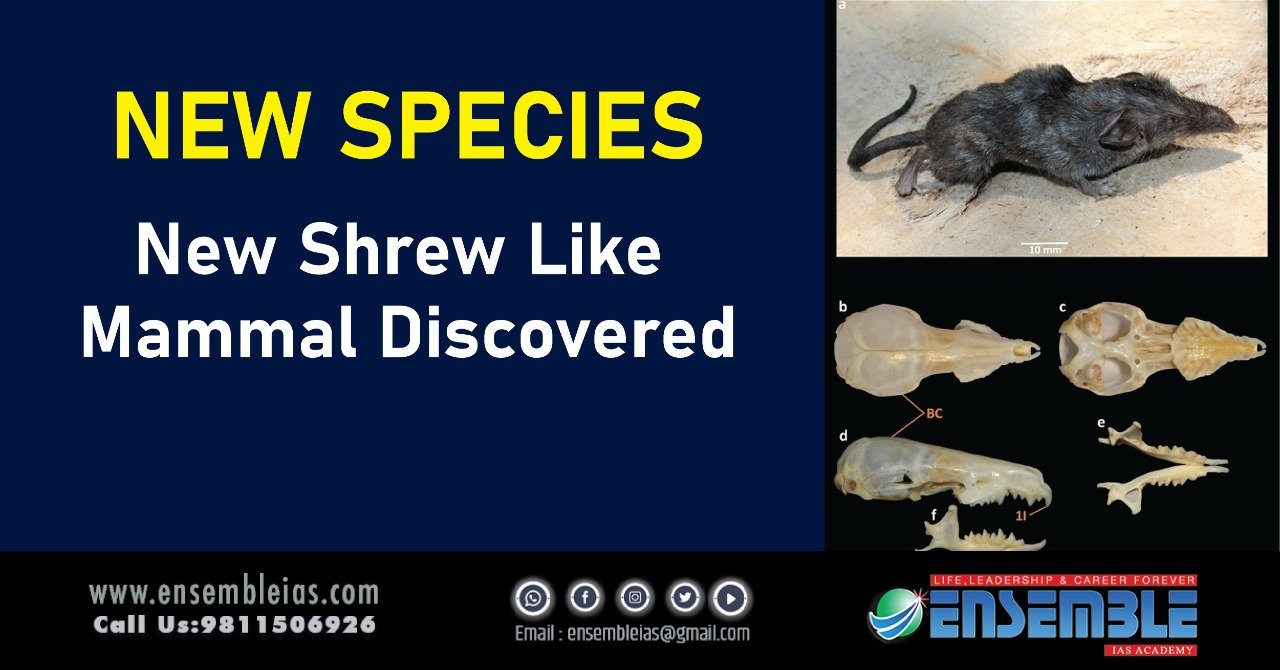New Shrew like mammal discovered: New species of mammal belonging to the shrew family discovered by Indian scientists of the Zoological Survey of India from the Andaman Islands. Species named Crocidura Narcondamica.
Two individuals (a male and a female) were captured from the same location using the pitfall method. Preserved in 70% molecular grade ethanol and later deposited in the National Zoological Collections, Zoological Survey of India (ZSI), Kolkata, India
To buy our online courses: Click Here
Crocidura
- Crocidura is one of nine biological classifications (genus) of the shrew subfamily Crocidurinae
- Members of the genus are commonly called white-toothed shrews or musk shrews
- The name Crocidura means “woolly tail” because the tail of the species is covered in short hairs interspersed with longer ones
- 24 Crocidura species have been newly discovered throughout the world in the last two decades between 2000 and 2020. 15 species were discovered in the Indo-Malayan region and Sundaland
- With 198 species, Crocidura contains the most species of any mammal genus. Found mostly in Africa, Europe, and Asia making it the most species-rich group of mammals
Shrews
- Shrews are small mole-like mammals. The shrew family with its 385 known species is the fourth-most successful mammal family. The population size is 100 billion in the world
- External appearances apart, a shrew is not a rodent and is more related to a hedgehog. Shrews have sharp, spike-like teeth, not the familiar gnawing front incisor teeth of rodents
- Shrews have small eyes and generally poor vision but have excellent senses of hearing and smell
- Active animals, with voracious appetites. Fiercely territorial, driving off rivals, and coming together only to mate
- Forage for seeds, insects, nuts, worms, and a variety of other foods in leaf litter and dense vegetation. Live from 12 to 30 months
- Due to their secretive behavior and conservative characters, shrews are the least studied mammal group
Distribution and habitat
- The new species lives in Narcondam Island, Andaman and Nicobar Archipelago, in the Bay of Bengal, India.
- The sample was collected from a littoral forest along the coastline at 11 m elevation. Uninhabited except for a security post.
- One of 836 islands of the AN Archipelago and is a small dormant volcanic island with almost 80% forest cover known for the occurrence of another endangered species, the Narcondam hornbill
- Scientists recorded 17 fishes, 8 reptiles, 28 birds, forest rats, Island Flying Fox, 13 spiders, 8 butterflies, and 2 sea cucumbers from this isolated island
- The first eruption of the volcano was recorded in the year 1787, since then it erupted 11 times with the most recent one being in Jan 2017
Also Read: ‘Black’ and ‘white’ in the greys of pandemic
Description
- Assigned to the genus Crocidura by the presence of three upper unicuspids
- Distinguished from all other Archipelago shrews by its body size and tail length, which are considerably shorter
- Possesses a darker-grey dense fur on its back and a thick and darker tail whereas the species known from the AN Archipelago possesses a different dorsal pelage and tail
- Rounded braincase, elevated with weak lambdoidal ridges in comparison to other close species.
- Considerably smaller from Indian and Myanmar varieties
- Results showed a 90% similarity with the available sequence of a specimen Crocidura collected from China.
